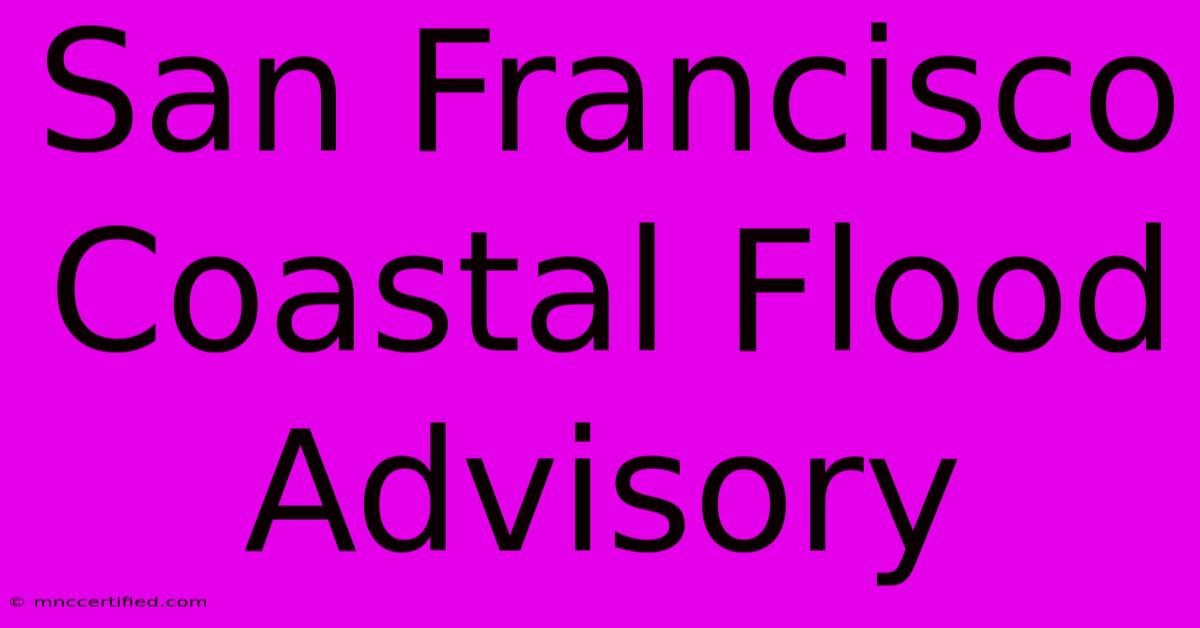San Francisco Coastal Flood Advisory

Table of Contents
San Francisco Coastal Flood Advisory: Understanding the Risks and Staying Safe
San Francisco, with its stunning coastline and iconic landmarks, is also vulnerable to coastal flooding. Understanding the risks associated with a San Francisco Coastal Flood Advisory is crucial for residents, businesses, and visitors alike. This comprehensive guide will explain what a coastal flood advisory means, the causes, potential impacts, and how to prepare and stay safe during such an event.
What is a Coastal Flood Advisory?
A Coastal Flood Advisory is issued by the National Weather Service (NWS) when there's a potential for minor coastal flooding. This isn't as severe as a Coastal Flood Warning, which indicates more significant flooding is imminent. However, a Coastal Flood Advisory still warrants attention and preparedness. In San Francisco, these advisories are often triggered by a combination of factors, primarily high tides, strong winds, and significant wave action. These conditions can lead to seawater inundating low-lying areas, causing disruptions and posing safety risks.
Key Differences: Advisory vs. Warning
It's vital to understand the difference between a Coastal Flood Advisory and a Coastal Flood Warning:
- Advisory: Indicates potential for minor coastal flooding. Be prepared, monitor conditions, and take precautions.
- Warning: Indicates significant coastal flooding is occurring or imminent. Take immediate action to protect life and property.
Causes of Coastal Flooding in San Francisco
Several factors contribute to coastal flooding in San Francisco:
- High Tides: Especially during periods of spring tides (when tidal ranges are greatest), high tides can easily overtop seawalls and flood vulnerable areas.
- Strong Winds: Strong winds, particularly from the west, can push water onshore, exacerbating the effects of high tides and creating storm surges. These are often associated with powerful weather systems.
- Large Waves: Large waves generated by storms at sea can crash over seawalls and contribute to coastal inundation. The intensity of these waves can be significant, especially during winter months.
- Sea Level Rise: Long-term sea level rise due to climate change is increasing the frequency and severity of coastal flooding events in San Francisco and globally. This is a critical factor to consider for long-term planning and mitigation strategies.
Potential Impacts of a Coastal Flood Advisory in San Francisco
The impacts of a Coastal Flood Advisory can range from minor inconveniences to significant disruptions:
- Road Closures: Low-lying roads and streets may become impassable due to flooding, leading to traffic delays and disruptions.
- Property Damage: Seawater can damage buildings, infrastructure, and personal property, especially in areas without adequate protection.
- Business Disruptions: Businesses located in vulnerable areas may experience closures or operational disruptions due to flooding and power outages.
- Beach Closures: Beaches may be closed to the public due to dangerous conditions and potential hazards.
- Erosion: Increased wave action and high tides can cause significant coastal erosion, damaging beaches and other coastal features.
Preparing for and Staying Safe During a Coastal Flood Advisory
Preparation is key to minimizing the impact of a coastal flood advisory:
- Stay Informed: Monitor weather forecasts and warnings from the National Weather Service and local news outlets. Sign up for emergency alerts.
- Know Your Risk: Identify if you live or work in a flood-prone area. Understand your evacuation route if necessary.
- Protect Your Property: Move valuable items to higher ground, secure outdoor furniture, and consider sandbagging if necessary.
- Have an Emergency Plan: Develop a family emergency plan that includes communication strategies, evacuation routes, and a supply kit.
- Heed Warnings: Evacuate if instructed to do so by authorities. Never attempt to drive or walk through floodwaters.
Resources for San Francisco Coastal Flood Information
- National Weather Service (NWS): The primary source for weather forecasts and warnings.
- City of San Francisco Office of Emergency Management: Provides information on emergency preparedness and response.
- California Governor's Office of Emergency Services (Cal OES): Offers resources and information related to statewide emergency preparedness.
By understanding the risks and taking proactive steps, you can significantly reduce the impact of a San Francisco coastal flood advisory and ensure your safety and well-being. Remember, preparedness is the best defense against coastal flooding.

Thank you for visiting our website wich cover about San Francisco Coastal Flood Advisory. We hope the information provided has been useful to you. Feel free to contact us if you have any questions or need further assistance. See you next time and dont miss to bookmark.
Featured Posts
-
Bonded Abrasive Disc Settlement
Nov 23, 2024
-
Dragonfly 2 Spikes Release Date
Nov 23, 2024
-
Sporting Amarante High Stakes Cup Opener
Nov 23, 2024
-
Coldplay Concert Tickets Fans Disappointment
Nov 23, 2024
-
Bomb Scare Gatwick Airport Terminal Reopens
Nov 23, 2024